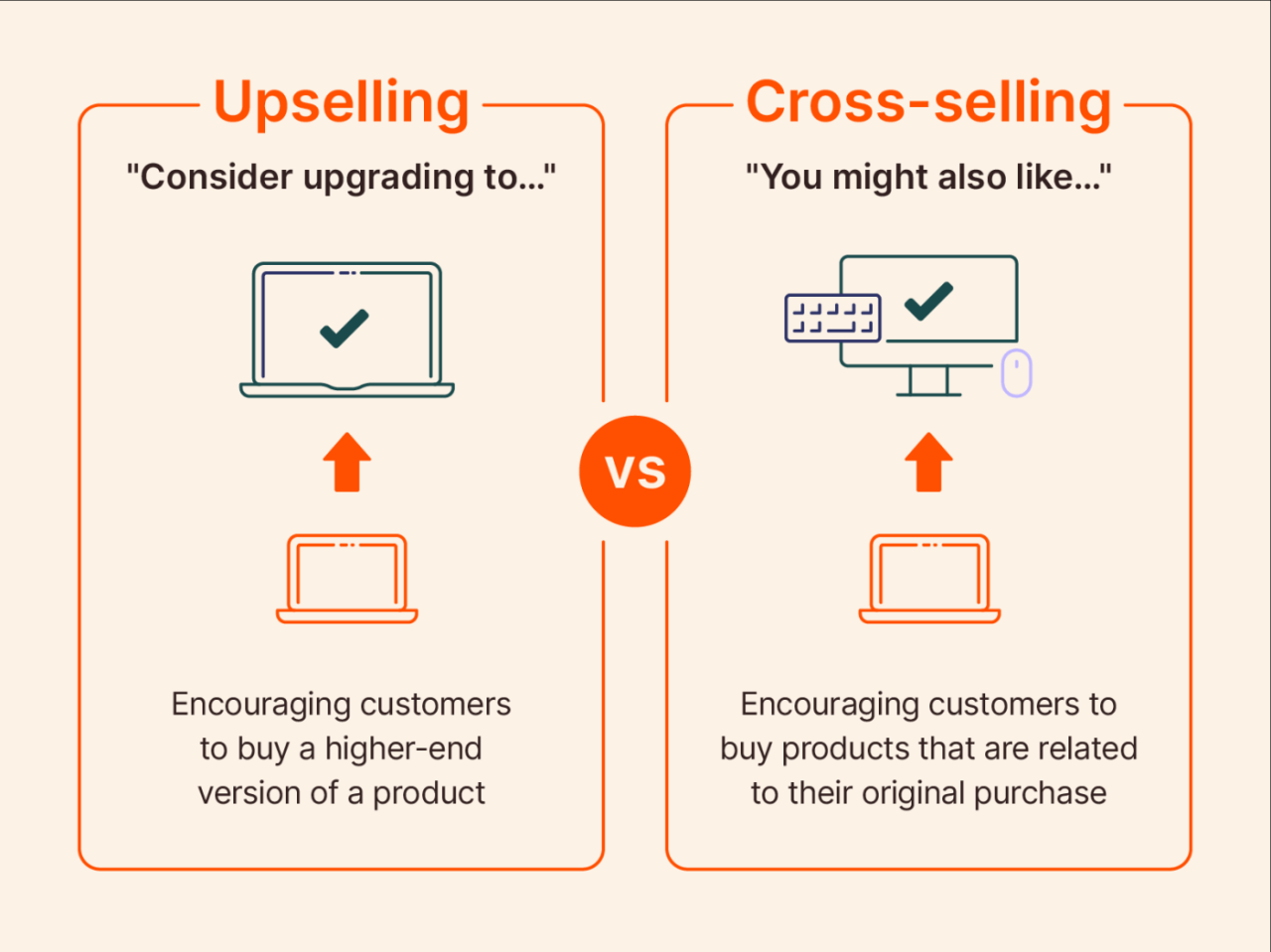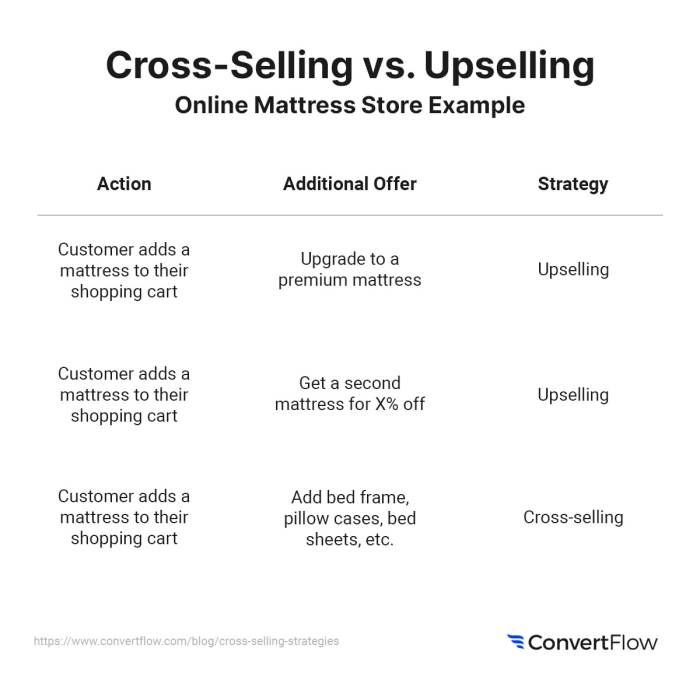Upselling and Cross-selling go hand in hand when it comes to maximizing profits and customer satisfaction. These techniques are essential in today’s competitive market, offering businesses innovative ways to increase revenue and build lasting relationships with their clients. Let’s dive into the world of Upselling and Cross-selling to uncover the secrets behind these powerful strategies.
Definition of Upselling and Cross-selling
Upselling and cross-selling are two essential sales techniques used by businesses to increase revenue and provide more value to customers.
Upselling
Upselling is the practice of persuading a customer to purchase a more expensive or upgraded version of the product they are already considering. This can involve highlighting the additional features or benefits of the higher-priced option to encourage the customer to make a larger purchase.
- Example: A fast-food restaurant employee asks a customer if they would like to upgrade their regular meal to a larger size for just a few dollars more.
- Example: A software company offers a premium version of their product with advanced features and support at a higher price point than the basic version.
Cross-selling
Cross-selling involves offering complementary or related products to customers to increase the value of their purchase and encourage them to buy additional items. This strategy focuses on suggesting products that enhance or supplement the original purchase.
- Example: An online retailer recommends matching accessories, such as a phone case or charger, when a customer buys a new smartphone.
- Example: A car dealership suggests add-on services like extended warranties or maintenance packages when a customer purchases a vehicle.
Benefits of Upselling and Cross-selling

Upselling and cross-selling are sales techniques that can bring numerous benefits to businesses and enhance customer satisfaction.
Advantages of Upselling for Businesses
Upselling allows businesses to increase their average order value by encouraging customers to purchase higher-end or additional products or services. By suggesting upgrades or complementary items, businesses can maximize their revenue from each transaction.
- Boosts revenue per customer
- Increases customer lifetime value
- Improves overall sales performance
Impact of Cross-selling on Customer Satisfaction, Upselling and Cross-selling
Cross-selling involves recommending related products or services to customers based on their initial purchase. This can enhance customer satisfaction by providing them with a more comprehensive solution to their needs and preferences.
- Enhances customer experience
- Builds trust and loyalty
- Increases customer retention rates
Effect of Upselling and Cross-selling on the Bottom Line
Implementing upselling and cross-selling strategies can have a significant impact on the bottom line of a business, leading to increased profitability and sustainable growth.
- Improves profit margins
- Drives overall revenue growth
- Helps in achieving sales targets
Strategies for Effective Upselling
When it comes to upselling, there are certain techniques and tips that can help you successfully increase sales and customer satisfaction. Personalizing your approach and timing your efforts effectively are key components of a successful upselling strategy.
Techniques to Upsell Products or Services Successfully
- Highlight the benefits: Clearly explain how the additional product or service will enhance the customer’s experience or provide added value.
- Bundle products: Offer complementary items or services together at a discounted price to encourage customers to purchase more.
- Create urgency: Use phrases like “limited time offer” or “while supplies last” to motivate customers to make a decision quickly.
- Provide social proof: Share testimonials or success stories from other customers who have benefited from the upsell.
Tips on How to Personalize Upselling Based on Customer Preferences
- Segment your customers: Divide your customer base into groups based on their preferences, purchase history, or demographics to tailor your upselling approach.
- Use data: Utilize customer data and purchase history to recommend relevant upsells that align with their interests and needs.
- Ask questions: Engage with customers to understand their specific needs and preferences, then offer personalized upsell suggestions based on that information.
The Importance of Timing in Upselling Efforts
- Timing is crucial: Choose the right moment to introduce an upsell, such as after a customer has made a purchase or when they are considering a related product.
- Avoid being pushy: Be mindful of not overwhelming customers with too many upsell offers or approaching them at an inconvenient time.
- Follow up: If a customer doesn’t accept the initial upsell offer, follow up at a later time with a different approach or offer that may better suit their needs.
Cross-selling Best Practices

When it comes to implementing a successful cross-selling strategy, there are some key principles that can help boost sales and enhance customer satisfaction. By bundling complementary products and services, businesses can maximize their revenue potential and provide added value to their customers. Let’s dive into some best practices for effective cross-selling.
Bundle Complementary Products
When cross-selling, it’s essential to bundle products that complement each other and provide additional value to the customer. For example, if a customer is purchasing a camera, you can cross-sell accessories like tripods, lenses, and camera bags. By offering these related products together, you can increase the overall sale value and enhance the customer’s shopping experience.
- Identify products that naturally go together and offer them as a package deal.
- Highlight the benefits of purchasing the bundled products, such as convenience and cost savings.
- Personalize recommendations based on the customer’s purchase history and preferences.
By bundling complementary products, businesses can increase their average order value and create a more seamless shopping experience for customers.
Successful Cross-selling Campaigns
Many companies have successfully implemented cross-selling strategies to drive revenue and build customer loyalty. One notable example is Amazon, which suggests related products based on a customer’s browsing and purchase history. By leveraging data and personalization, Amazon has been able to increase sales and create a more tailored shopping experience for its customers.
- Netflix is another example of effective cross-selling, offering personalized recommendations for TV shows and movies based on a user’s viewing habits.
- Coca-Cola often pairs its beverages with snack items in promotional campaigns, encouraging customers to purchase complementary products together.
- Apple cross-sells its products by recommending accessories like cases, headphones, and chargers to customers buying iPhones, iPads, and MacBooks.
Tools and Technologies for Upselling and Cross-selling
When it comes to upselling and cross-selling, having the right tools and technologies can make a significant difference in your success. Let’s take a look at some of the software and technologies that can assist in these efforts.
Customer Relationship Management (CRM) Systems
Customer Relationship Management (CRM) systems play a crucial role in enhancing upselling and cross-selling efforts. These systems help businesses track customer interactions, preferences, and purchase history, allowing them to identify upselling and cross-selling opportunities. By analyzing customer data stored in CRM systems, businesses can create targeted offers and personalized recommendations to increase sales.
Data Analytics
Data analytics is another essential tool for optimizing upselling and cross-selling strategies. By leveraging data analytics tools, businesses can gain valuable insights into customer behavior, preferences, and buying patterns. This data-driven approach enables businesses to identify trends, forecast customer needs, and tailor their upselling and cross-selling strategies accordingly. Data analytics can also help businesses measure the effectiveness of their upselling and cross-selling efforts, allowing them to make data-driven decisions to maximize revenue.